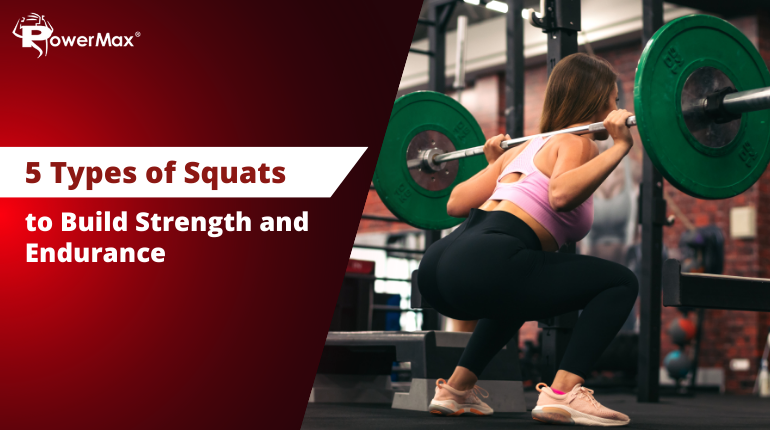5 Types of Squats: A Comprehensive Guide to Building Strength and Endurance

Team PowerMax

03 Nov 2025

Introduction: 5 Types Of Squats
Among the best workouts for developing strength, flexibility, and athletic performance are squats. Including squats into your exercise program will help you reach your fitness objectives regardless of your level of experience with exercise. Not all squats, meantime, are made equally. Each of the several squat variations targets various muscles and has many benefits of doing squats. Five types of squats will be discussed in this article to assist you build lower body strength, improve mobility, and avoid injuries.
1. Bodyweight Squat
The most basic variation on a squat and the basis for all other forms of squats is the bodyweight squat. Performed anyplace without any equipment, this basic but effective workout is easy. Mostly targeting the quadriceps, hamstrings, glutes, and core muscles, this squat
How to Perform a Bodyweight Squat:
-
Stand with shoulder-width apart feet.
-
Maintaining your chest up and back straight,
-
Bending your knees and pressing your hips back will help you to lower your body.
-
Go down until, if flexibility permits, your thighs parallel the ground or lower.
-
To get back to the beginning, push through your heels.
Benefits of Bodyweight Squat:
-
increases lower body endurance and power.
-
improves movement and adaptability.
-
Provides an excellent warm-up workout.
-
Ideal for both novice and experienced sportsmen.
2. Goblet Squat
A beginners' friendly variation that increases bodyweight squat resistance is the goblet squat. Doing the movement at chest level, you grasp a dumbbell or kettlebell. This variation stresses upper body stability and the core more highly.
How to Perform a Goblet Squat:
-
With both hands, grip a kettlebell or dumbbell around your chest.
-
Stand with your feet somewhat apart—that is, wider than shoulder-width.
-
Tuck your elbows in and raise your chest.
-
Still in an erect stance, lower yourself into a squat.
-
To get back to the beginning position, push through your heels.
Benefits of Goblet Squats:
-
increases posture and core stability.
-
promotes correct squats techniques.
-
increases the legs, glues, and upper body strength.
-
facilitates increase of hip and ankle mobility and flexibility.
3. Back Squat
A classic compound exercise, the back squat entails the squat movement while a barbell is placed on the upper back. Because it increases general lower body strength, this variance is a mainstay of strength training and powerlifting programs if you are beginner you can also use smith machine for doing squats safely.
How to Perform a Back Squat:
-
Lean a barbell across your upper back, resting it on your traps.
-
With your feet shoulder-width apart, stand.
-
Brace your core then bend your knees to gently descend your body.
-
Straight your back and raise your chest.
-
Lower yourself till the ground's parallel to your thighs.
-
To get back to the beginning, push through your heels.
Benefits of Back Squats:
-
builds general lower body power and strength.
-
Works the stabilising and core muscles.
-
improves athletic performance in sports needing explosive motions.
-
Boosts joint health and bone density.
4. Front Squat
Though the barbell is placed front of the shoulders instead of the upper back, the front squat is like the back squat. This posture moves the centre of gravity forward and calls stronger upper body stability and core involvement.
How to Perform a Front Squat:
-
Maintaining high elbows, rest the barbell on the front of your shoulders.
-
Stand with shoulder-width apart feet.
-
Keeping your chest straight, drop yourself into a squat.
-
Make sure your elbows keep elevated all through the exercise.
-
To get back to the beginning position, push through your heels.
Benefits of Front Squats:
-
Works the quadriceps more than back squats.
-
improves basic stability and strength.
-
Less spinal compression than in back squats.
-
promotes mobility and posture.
5. Bulgarian Split Squat
A single-leg squat variation, the Bulgarian split squat calls for one foot to be raised on a bench or platform behind you. Excellent for developing unilateral strength, enhancing balance, and correcting muscular imbalances, this workout
How to Perform a Bulgarian Split Squat:
-
Position one foot behind a bench several feet ahead of it.
-
Maintaining your torso straight and chest raised,
-
Bending your front knee will help you to lower yourself till your rear knee almost makes contact with the ground.
-
To get back to the beginning position, push through your front heel.
Benefits of Bulgarian Split Squats:
-
strengthens and stabilises single legs.
-
improve coordination and balance.
-
correct muscular imbalances across legs.
-
Lessens lower back strain than conventional squats.
Conclusion
Developing lower body strength, increasing athletic performance, and raising general health all depend on squats. It's crucial to include several squat variations in your training since each one stimulates distinct muscle regions and provides special advantages. These five squat variants will help you reach your fitness objectives whether your level of experience is advanced lifter doing front squats and Bulgarian split squats or novice mastering bodyweight squats. Always pay close attention to correct form; progressively raise intensity; and savour the several advantages squats have to provide!
 India (INR)
India (INR)
 UAE (AED)
UAE (AED)
 Store Locator
Store Locator



-thumb.jpg)
-thumb.jpg)
-thumb.jpg)
-thumb.jpg)
-thumb.jpg)
-thumb.jpg)
-thumb.jpg)
-thumb.jpg)
-thumb.jpg)
-thumb.jpg)